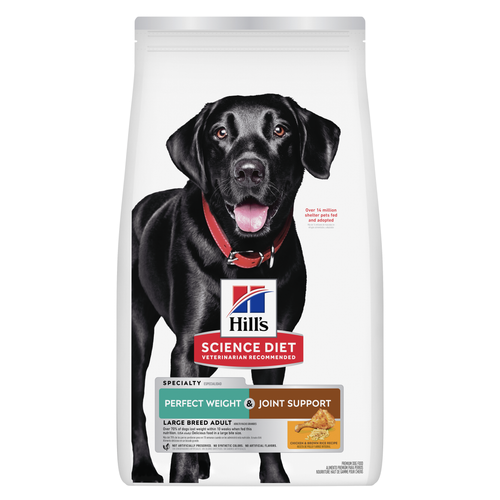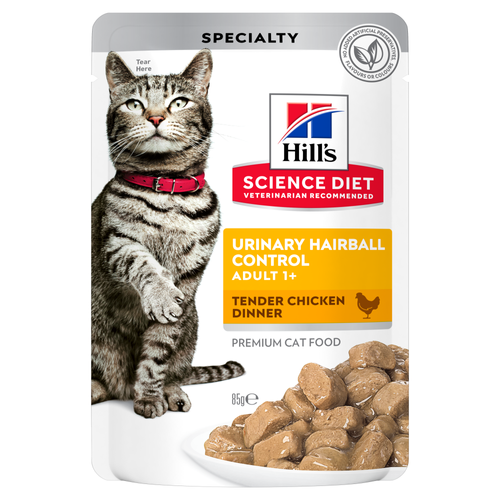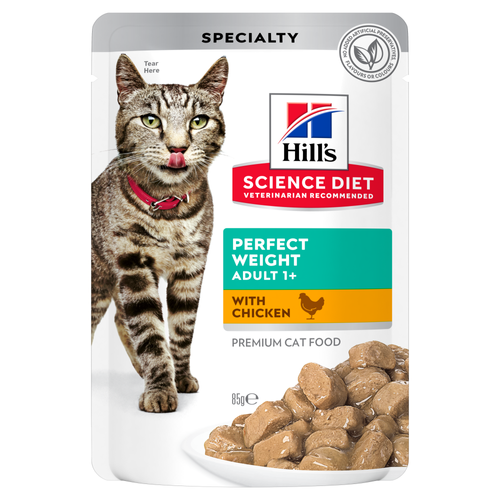
-
Find the right food for your petTake this quiz to see which food may be the best for your furry friend.Find the right food for your petTake this quiz to see which food may be the best for your furry friend.Health CategoryFeatured products
 Adult Salmon & Brown Rice Recipe Dog Food
Adult Salmon & Brown Rice Recipe Dog FoodSupports lean muscle and beautiful coat for adult dogs
Shop Now Adult 7+ Healthy Cuisine Roasted Chicken, Carrots & Spinach Stew Dog Food
Adult 7+ Healthy Cuisine Roasted Chicken, Carrots & Spinach Stew Dog FoodDelicious roasted chicken paired with tender vegetables in a succulent stew
Shop Now Perfect Weight & Joint Support Large Breed Chicken & Brown Rice Recipe Dog Food
Perfect Weight & Joint Support Large Breed Chicken & Brown Rice Recipe Dog FoodThis weight management and mobility support dog food was created with Hill’s unique understanding of the biology of overweight dogs
Shop NowFeatured products Adult Salmon & Brown Rice Recipe Cat Food
Adult Salmon & Brown Rice Recipe Cat FoodSupports lean muscle and beautiful fur for adult cats
Shop Now Adult Urinary Hairball Control Tender Chicken Dinner Cat Food
Adult Urinary Hairball Control Tender Chicken Dinner Cat FoodPrecisely balanced nutrition to support urinary health from kidney to bladder. With natural fibre technology to help reduce hairballs.
Shop Now Adult Perfect Weight with Chicken Cat Food
Adult Perfect Weight with Chicken Cat FoodBreakthrough nutrition for your cat’s healthy weight maintenance and long-lasting weight support
Shop Now -
DogCat
- Cat Tips & Articles
-
Health Category
- Weight
- Skin & Food Sensitivities
- Urinary
- Digestive
- Kidney
- Dental
- Serious Illness
-
Life Stage
- Kitten Nutrition
- Adult Nutrition
Featured articles Water
WaterWater is the most important nutrient of all and essential for life. Animals can lose almost all their fat and half their protein and still survive, but if they lose 15% of their water, it will mean death.
Read More Pet Food Storage Tips
Pet Food Storage TipsWhere you store your cat and dog food can make a big difference in the quality and freshness once it is opened. Here are some common questions and recommendations for optimal storage for all of Hill’s dry and canned cat and dog food.
Read More The Right Diet For Your Pet
The Right Diet For Your PetLearn what to look for in healthy pet food & nutrition, including ingredients, quality of the manufacturer, your pet's age, and any special needs they have.
Read More -



Large and giant breed dogs — Great Danes, German shepherds, Labrador retrievers and the like — have different nutritional needs than smaller breeds. All puppies are born with their bones still developing, but large breed puppies are more susceptible to developmental bone and joint disease during their rapid growth phase to 1 year of age. In fact, large breeds reach 50 percent of their body weight at around 5 months of age. Smaller breeds reach 50 percent of their body weight at around 4 months of age.
The growth rates of all puppies are dependent on the food that they eat. Puppies should be fed to grow at an average, rather than a maximum, growth rate. Compared to smaller-sized puppies, large breed puppies need restricted levels of fat and calcium to moderate their rate of growth. They’ll still reach their full-grown size, just over a longer period of time, which will result in healthy development of bones and joints for these breeds.
Two key nutrients that should be decreased for large breed puppies are fat (and total calories) and calcium:
- Fat: High fat/calorie intake causes rapid weight gain, and bones/muscles aren’t developed enough to support the excessive body weight. Controlling the fat level and total calories in the food for these puppies may help reduce the risk of developmental bone and joint problems.
- Calcium: Excessive calcium intake increases the likelihood of skeletal problems. It is also recommended that calcium supplements not be fed with any commercial pet food for growth.
Hill’s Large Breed products are designed to help large breed dogs live long, quality lives. We limit the levels of calcium and fat in Hill’s Science Diet Puppy Large Breed dog food, but we do add high levels of certain nutrients that have been shown to benefit big dogs — like omega-3 fatty acids, L-carnitine and the highest levels of the antioxidant vitamins E+C versus all leading brands. These nutrients help maintain healthy joints and cartilage because large breed dogs are more likely to put stress on their joints due to their size. Mastiffs, Labs ,and all the other large and giant breeds that we love can benefit from precisely balanced nutrition to live their lives to the fullest.


Tasty Tips
Related products

Supports lean muscle and beautiful coat for adult dogs

Gentle on stomachs while nourishing skin & supporting development in growing puppies

Delicious roasted chicken paired with tender vegetables in a succulent stew

This weight management and mobility support dog food was created with Hill’s unique understanding of the biology of overweight dogs
Related articles

Selecting the right food for your puppy is a key to quality nutrition and a long, healthy life., Learn more about how to select the right puppy food.

A dog with a sensitive stomach has special needs. Learn more about sensitive stomach symptoms in your dog, what you can do to help sooth your pet’s insides and get recommendations on sensitive stomach dog food.

Learn what you can feed your pregnant or nursing dog to keep her and her new pups healthy.

Though it may seem like your four-legged friend loves nothing more than to nap on the couch, dogs need regular exercise to stay healthy just like people do.

Put your dog on a diet without them knowing
Our low calorie formula helps you control your dog's weight. It's packed with high-quality protein for building lean muscles, and made with purposeful ingredients for a flavorful, nutritious meal. Clinically proven antioxidants, Vitamin C+E, help promote a healthy immune system.
Put your dog on a diet without them knowing
Our low calorie formula helps you control your dog's weight. It's packed with high-quality protein for building lean muscles, and made with purposeful ingredients for a flavorful, nutritious meal. Clinically proven antioxidants, Vitamin C+E, help promote a healthy immune system.


